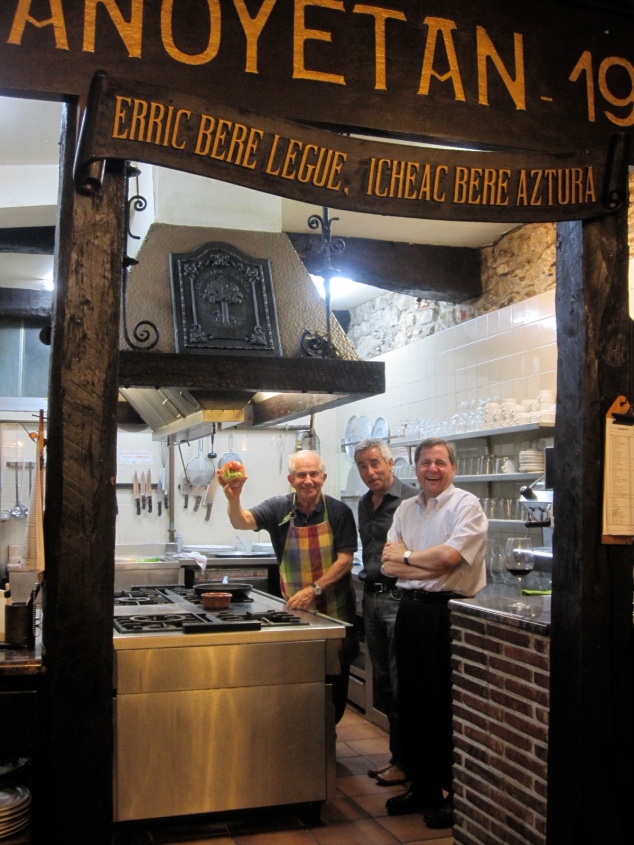 Last, but certainly not least, on the gastronomic tour was lunch at Mugaritz. Located about half an hour drive from San Sebastian, in the country side village of Errenteria. Chef Andoni Luis Aduriz established this restaurant in 1998, after having worked as a part of Chef Ferran Adriá’s team at El Bulli. The restaurant is nestled in the hillside surrounded by gardens in which they cultivate many of the ingredients used in the kitchen.
Last, but certainly not least, on the gastronomic tour was lunch at Mugaritz. Located about half an hour drive from San Sebastian, in the country side village of Errenteria. Chef Andoni Luis Aduriz established this restaurant in 1998, after having worked as a part of Chef Ferran Adriá’s team at El Bulli. The restaurant is nestled in the hillside surrounded by gardens in which they cultivate many of the ingredients used in the kitchen.
 Upon arrival, before even being seated, you are brought into the kitchen where Chef Aduriz himself, along with his head chef, explain their philosophy – they use only the freshest ingredients, tailoring the menu to what they find in local markets each day. Each and every plate is scrutinized for perfection before leaving the kitchen.
Upon arrival, before even being seated, you are brought into the kitchen where Chef Aduriz himself, along with his head chef, explain their philosophy – they use only the freshest ingredients, tailoring the menu to what they find in local markets each day. Each and every plate is scrutinized for perfection before leaving the kitchen.

 After an amuse-bouche in the kitchen we are taken to the table – a huge, circular table with white linen and with no silverware. Mugaritz only serves a 20 course tasting menu and shortly after sitting, and after choosing our first bottle of wine with the help of the sommelier, the first of five amuse-bouche begin to arrive, all of which are eaten sans utensils.
After an amuse-bouche in the kitchen we are taken to the table – a huge, circular table with white linen and with no silverware. Mugaritz only serves a 20 course tasting menu and shortly after sitting, and after choosing our first bottle of wine with the help of the sommelier, the first of five amuse-bouche begin to arrive, all of which are eaten sans utensils.

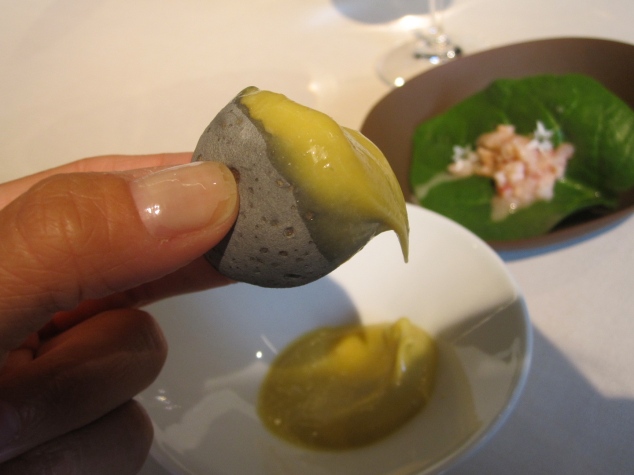 “Edible Stones” First up, a dish that really does look like two stones nestled in a bowl of sand. The waiter coyly says, “If you find you can bite into them, try dipping them in the aioli…” The “stones” are small baked potatoes and somehow the skin is made to look like a stone. It has us giggling as we try to bite into the stones and encounter a perfectly buttery potato. And thus starts an incredible meal.
“Edible Stones” First up, a dish that really does look like two stones nestled in a bowl of sand. The waiter coyly says, “If you find you can bite into them, try dipping them in the aioli…” The “stones” are small baked potatoes and somehow the skin is made to look like a stone. It has us giggling as we try to bite into the stones and encounter a perfectly buttery potato. And thus starts an incredible meal.
 “Scarlett Shrimp over Sake Lees” A take on a lettuce wrap, we must roll up the filling in the leaf to eat it. The sheer uniqueness of eating a leaf with little flowers in it gets us going all over again. It’s surprisingly tasty and we realize we are definitely in for a lot of surprises today.
“Scarlett Shrimp over Sake Lees” A take on a lettuce wrap, we must roll up the filling in the leaf to eat it. The sheer uniqueness of eating a leaf with little flowers in it gets us going all over again. It’s surprisingly tasty and we realize we are definitely in for a lot of surprises today.
 “Grilled Toast with Bone Marrow, Herbs and Horseradish Ash” This next one is a doozy – I’ve never seen such a large pice of bone marrow. Its fatty and succulent and just over the top, but in such a good way.
“Grilled Toast with Bone Marrow, Herbs and Horseradish Ash” This next one is a doozy – I’ve never seen such a large pice of bone marrow. Its fatty and succulent and just over the top, but in such a good way.
 “Flax and Wheat “Kraft” Paper with Marine Accents” A lump of tender crab meat on a paper thin cracker.
“Flax and Wheat “Kraft” Paper with Marine Accents” A lump of tender crab meat on a paper thin cracker.

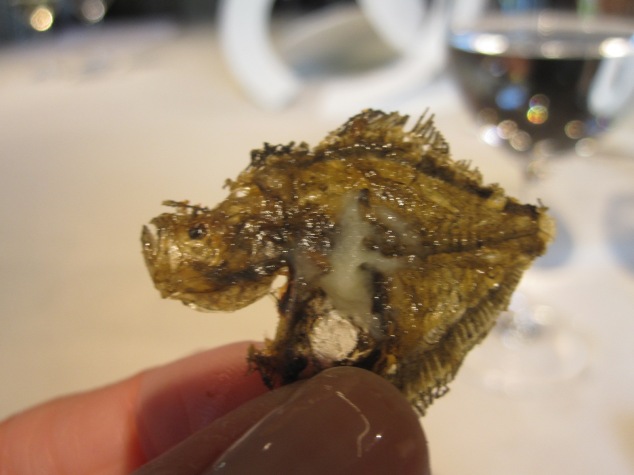 “‘Fishbones’ with Nuances of Lemon, Garlic, and Cayenne Pepper” Teeny tiny little fish, fried and stuck together with dab of a spicy sauce between each one. Salty, crunchy with a spicy kick.
“‘Fishbones’ with Nuances of Lemon, Garlic, and Cayenne Pepper” Teeny tiny little fish, fried and stuck together with dab of a spicy sauce between each one. Salty, crunchy with a spicy kick.
 For all of this we have been sipping on this Ossian 2009 Verdejo from the Rueda region. A light golden, crisp wine with hints citrus.
For all of this we have been sipping on this Ossian 2009 Verdejo from the Rueda region. A light golden, crisp wine with hints citrus.



 “‘Bonding…’ Toasted Seeds and Spices Served in a Mortar with Vegetable Broth” Next up, a sort of make-your-own-soup. We’re served a warm cast iron mortar full of hemp seeds and peppercorns and told we need to mash them up. It seems strange at first, but as we start mashing, a wonderful toasted aroma starts to rise out of our bowls as the mashed seeds come into contact with the heat of the cast iron. Once we’re sufficiently mashed (and by that I mean the waiter has come around to ensure we’ve put enough muscle into it) we are served a couple slices of cod and a small pitcher of creamy vegetable broth, which we add to the seeds.
“‘Bonding…’ Toasted Seeds and Spices Served in a Mortar with Vegetable Broth” Next up, a sort of make-your-own-soup. We’re served a warm cast iron mortar full of hemp seeds and peppercorns and told we need to mash them up. It seems strange at first, but as we start mashing, a wonderful toasted aroma starts to rise out of our bowls as the mashed seeds come into contact with the heat of the cast iron. Once we’re sufficiently mashed (and by that I mean the waiter has come around to ensure we’ve put enough muscle into it) we are served a couple slices of cod and a small pitcher of creamy vegetable broth, which we add to the seeds.
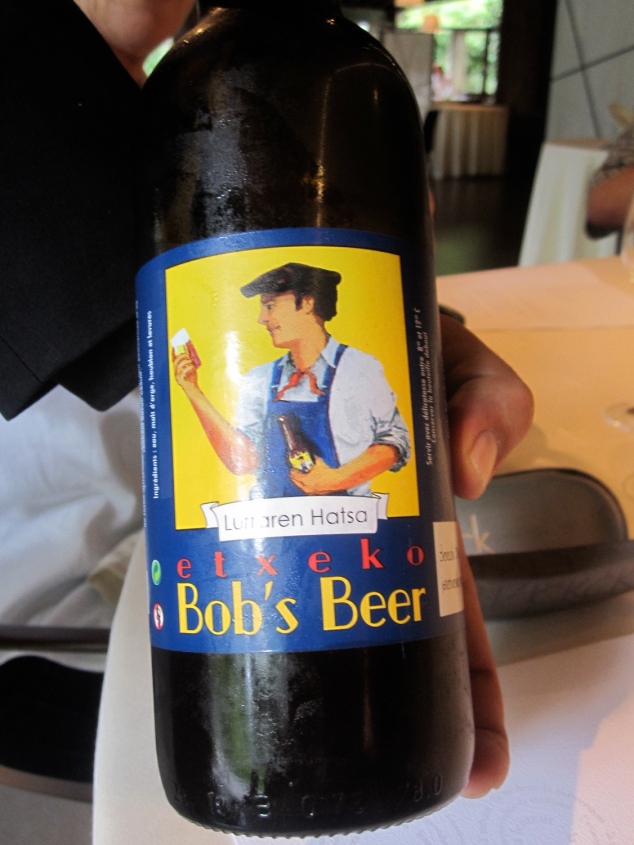
 For this dish we switch momentarily to a beer to complement the nutty flavors of the hemp seeds. Not just any beer of course, a beer brewed especially for Mugaritz.
For this dish we switch momentarily to a beer to complement the nutty flavors of the hemp seeds. Not just any beer of course, a beer brewed especially for Mugaritz.
 “Tomato and Sweet Garlic” And this is how the next set of courses begins – a thick slice of heirloom tomato with black fermented garlic imported from China spread over top. The garlic is surprisingly sweet and has a very mild garlic flavor. It’s a perfect combination with the juicy acid of the tomato.
“Tomato and Sweet Garlic” And this is how the next set of courses begins – a thick slice of heirloom tomato with black fermented garlic imported from China spread over top. The garlic is surprisingly sweet and has a very mild garlic flavor. It’s a perfect combination with the juicy acid of the tomato.
 “Scarlet Prawns, Fresh Pasta, and Tomato” Next is a couple bites of fresh, possibly rice, pasta in a creamy broth made of prawns and tomato. The broth’s concentrated flavor is intense and complex and leaves you wanting another bite.
“Scarlet Prawns, Fresh Pasta, and Tomato” Next is a couple bites of fresh, possibly rice, pasta in a creamy broth made of prawns and tomato. The broth’s concentrated flavor is intense and complex and leaves you wanting another bite.
 “Stew of Lemon Rinds and Grilled Squid” Ohmygosh, so delicious. The squid is tender and the sauce is so intensely sweet and tangy. There are pieces of lemon rind in there also that have taken on a sweet flavor, like lemon rind candy. It clearly tastes like lemon, but without any sour flavor.
“Stew of Lemon Rinds and Grilled Squid” Ohmygosh, so delicious. The squid is tender and the sauce is so intensely sweet and tangy. There are pieces of lemon rind in there also that have taken on a sweet flavor, like lemon rind candy. It clearly tastes like lemon, but without any sour flavor.
 Pause. We need more wine. Sommelier, what’s the word? Ekam 2010 from Castell d’Encus: a combination of Riesling and Albariño with a bright gold color and with a floral sweetness. It’s a limited production from the Catalan Pyrenees. And it’s delicious.
Pause. We need more wine. Sommelier, what’s the word? Ekam 2010 from Castell d’Encus: a combination of Riesling and Albariño with a bright gold color and with a floral sweetness. It’s a limited production from the Catalan Pyrenees. And it’s delicious.
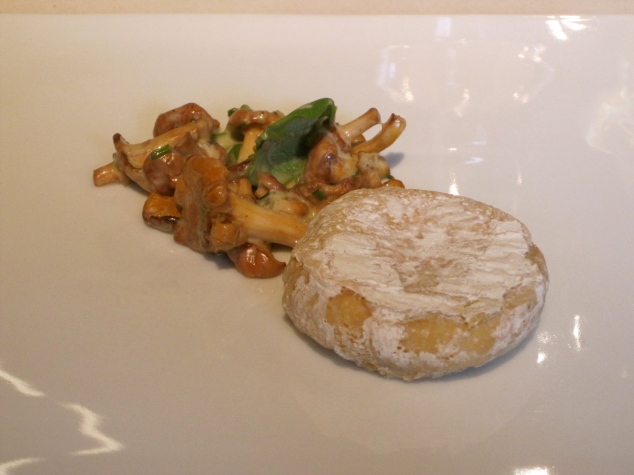
 “Portion of Home-made Cheese, Cured in Its Own Rind, Mushrooms and Fleshy Leaves” This next dish again plays with your perceptions. It looks a lot like cheese, but as the waiter sets down the dish he asks, “Is it cheese? You decide. I’ll tell you afterwards…” And… cue tablewide debate about whether it’s cheese or not. We decide it’s not cheese – the texture is just not quite right – and we get a gold star; its not cheese, and though it’s made with milk, the process is different. It has a yeasty flavor, kind of like when you make bread dough, and the texture is similar as well.
“Portion of Home-made Cheese, Cured in Its Own Rind, Mushrooms and Fleshy Leaves” This next dish again plays with your perceptions. It looks a lot like cheese, but as the waiter sets down the dish he asks, “Is it cheese? You decide. I’ll tell you afterwards…” And… cue tablewide debate about whether it’s cheese or not. We decide it’s not cheese – the texture is just not quite right – and we get a gold star; its not cheese, and though it’s made with milk, the process is different. It has a yeasty flavor, kind of like when you make bread dough, and the texture is similar as well.
 “Tagliatelle of Concentrated Milk, Lightly Soaked in a Silky Juice of Roasted Squash and Tomato” This is another crazy “milk technique” where the “pasta” is made by drying the film of milk that occurs when it boils. The dish arrives with this dry pasta wrapped by a thin slice of cured Iberian ham fat and at the table the broth is poured over, instantly making the “pasta” melt. It’s strangely delicious.
“Tagliatelle of Concentrated Milk, Lightly Soaked in a Silky Juice of Roasted Squash and Tomato” This is another crazy “milk technique” where the “pasta” is made by drying the film of milk that occurs when it boils. The dish arrives with this dry pasta wrapped by a thin slice of cured Iberian ham fat and at the table the broth is poured over, instantly making the “pasta” melt. It’s strangely delicious.

 For the last four dishes, the meat courses, we order a red wine. An Artigas 2008 from Bodegas Mas Alta from the Priorat region. A smooth full bodied red with a touch of dried cherry.
For the last four dishes, the meat courses, we order a red wine. An Artigas 2008 from Bodegas Mas Alta from the Priorat region. A smooth full bodied red with a touch of dried cherry.
 “Roasted Loin of Hake with Clashing Grains of Aged Mascarpone, Cauliflower, and Fresh Almonds” The first of the four second courses is hake, a flaky white fish common in Spain. On top is a ground up mixture of aged mascarpone, cauliflower, and fresh almonds, all of which seem to have the same texture, making them indistinguishable as you eat it, melding all of the flavors together.
“Roasted Loin of Hake with Clashing Grains of Aged Mascarpone, Cauliflower, and Fresh Almonds” The first of the four second courses is hake, a flaky white fish common in Spain. On top is a ground up mixture of aged mascarpone, cauliflower, and fresh almonds, all of which seem to have the same texture, making them indistinguishable as you eat it, melding all of the flavors together.
 “Costal Fish with Crunchy Trimmings of Aged Sourdough and Sweet Pickled Onion” The next dish is a tender rock fish, the soft texture and mild flavor of which goes perfectly with the crunch and tangy flavor of the toppings.
“Costal Fish with Crunchy Trimmings of Aged Sourdough and Sweet Pickled Onion” The next dish is a tender rock fish, the soft texture and mild flavor of which goes perfectly with the crunch and tangy flavor of the toppings.

 “Crispy Sweetbread with Homemade capers, Bitter Leaves, and Artisan Praline” Ah, sweetbreads…can’t really say a bad thing about them. These are amazing of course, crispy outside, tender inside.
“Crispy Sweetbread with Homemade capers, Bitter Leaves, and Artisan Praline” Ah, sweetbreads…can’t really say a bad thing about them. These are amazing of course, crispy outside, tender inside.
 “Crunchy Terrine of Iberian Pig Tails with a Bunch of Bitter Leaves and Txakoli Sediments” The last dish (before desserts, of course) is thin slices of pig tail pressed together to form this disc shape. I have to recognize that I am not a huge fan of pig tails as I don’t particularly care for the texture. At the same time, I must say that this was an excellent example of them – if you had to eat them, these would be the ones to eat. They are perfectly cooked, so that they are soft inside and the fat has melted, the skin on the outside is crunchy. Txakoli, as I mentioned in my last post, is a dry, highly acidic white wine typical of the Basque country, so the tart flavor of this sauce pairs really nicely with this dish, as it breaks up the salty fattiness.
“Crunchy Terrine of Iberian Pig Tails with a Bunch of Bitter Leaves and Txakoli Sediments” The last dish (before desserts, of course) is thin slices of pig tail pressed together to form this disc shape. I have to recognize that I am not a huge fan of pig tails as I don’t particularly care for the texture. At the same time, I must say that this was an excellent example of them – if you had to eat them, these would be the ones to eat. They are perfectly cooked, so that they are soft inside and the fat has melted, the skin on the outside is crunchy. Txakoli, as I mentioned in my last post, is a dry, highly acidic white wine typical of the Basque country, so the tart flavor of this sauce pairs really nicely with this dish, as it breaks up the salty fattiness.


 “A Taste of Subtlety. Folded Linen with Toasted Crème Fraiche and Crème Caramel” The first of the desserts is a paper thin wafer, served on a white linnen napkin. To the side, a butter knife with a delicious frosting of crème fraiche and crème caramel. You are told to spread the frosting over the wafer first. It’s has a buttery texture and just a hint of sweetness intermixed with the tangy crème fraiche.
“A Taste of Subtlety. Folded Linen with Toasted Crème Fraiche and Crème Caramel” The first of the desserts is a paper thin wafer, served on a white linnen napkin. To the side, a butter knife with a delicious frosting of crème fraiche and crème caramel. You are told to spread the frosting over the wafer first. It’s has a buttery texture and just a hint of sweetness intermixed with the tangy crème fraiche.
 “‘Traditional’ Almond Fairy Cake” Next up is a new take on a typical pastry called a mantecado, which is like a crumbly cookie that is traditionally made with ground almond. This is a frozen version made with a light airy almond ice cream that’s then coated with crumbled mantecado and ground almonds.
“‘Traditional’ Almond Fairy Cake” Next up is a new take on a typical pastry called a mantecado, which is like a crumbly cookie that is traditionally made with ground almond. This is a frozen version made with a light airy almond ice cream that’s then coated with crumbled mantecado and ground almonds.

 “Fig Leaves and Lemon in a Creamy Milkshake” Number three is my favorite by far. The milkshake is served with a small vile of fig extract, which you may add to your milkshake with the pipette. The flavors are incredible: sweet figs and tangy lemon all in a creamy, cold milkshake.
“Fig Leaves and Lemon in a Creamy Milkshake” Number three is my favorite by far. The milkshake is served with a small vile of fig extract, which you may add to your milkshake with the pipette. The flavors are incredible: sweet figs and tangy lemon all in a creamy, cold milkshake.

 “Candies of Frankincense. The Perfume of Eucalyptus Bark” Number four is the strangest thing I’ve ever eaten. Out to the table comes a bowl with wispy smoke and the smell of incense. At first glance, it looks like there are three sticks of incense sticking out of the bowl, but then we are told that actually, those sticks are what we need to eat! They remind me of drawing with charcoal sticks in art class and they smell like smoke. But, they taste like sugar and incense and melt away in your mouth like a sugar cube.
“Candies of Frankincense. The Perfume of Eucalyptus Bark” Number four is the strangest thing I’ve ever eaten. Out to the table comes a bowl with wispy smoke and the smell of incense. At first glance, it looks like there are three sticks of incense sticking out of the bowl, but then we are told that actually, those sticks are what we need to eat! They remind me of drawing with charcoal sticks in art class and they smell like smoke. But, they taste like sugar and incense and melt away in your mouth like a sugar cube.
 “Cocoa Dusted Hazelnuts” Lastly, a box of toasted hazelnuts dusted in unsweetened cocoa powder.
“Cocoa Dusted Hazelnuts” Lastly, a box of toasted hazelnuts dusted in unsweetened cocoa powder.
 To end the experience, the waiter comes by with moist towels for us to wash our hands. But, this is Mugaritz, so of course they aren’t your average towelettes. These are condensed cloths that expand when liquid is poured over them, in this case a warm peppermint infusion.
To end the experience, the waiter comes by with moist towels for us to wash our hands. But, this is Mugaritz, so of course they aren’t your average towelettes. These are condensed cloths that expand when liquid is poured over them, in this case a warm peppermint infusion.
Ah, it’s all so strange and whimsical… They make you interact with your food, eat with your hands, and question everything you thought you knew about some of the most common ingredients. Chef Aduriz is young and has a fantastic imagination and it all shows in his dishes. It’s somehow less serious, at times it makes you laugh at your own confusion, and at the end you leave feeling lighthearted and amazed.
After a fantastic meal, we took a walk around the gardens, which are beautiful, so below are some pictures of their vegetable garden and edible flowers (many of which appeared on our plates).








